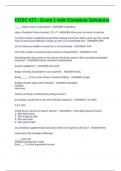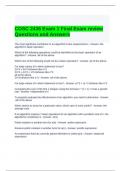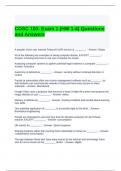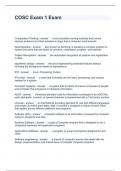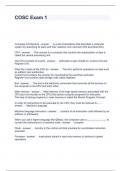Cosc exam 1 - Study guides, Class notes & Summaries
Looking for the best study guides, study notes and summaries about Cosc exam 1? On this page you'll find 286 study documents about Cosc exam 1.
Page 3 out of 286 results
Sort by
COSC 477 - Exam 1 with Complete Solutions
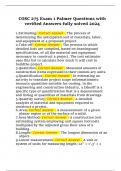
-
COSC 275 Exam 1 Palmer Questions with verified Answers fully solved 2024
- Exam (elaborations) • 14 pages • 2024
-
- $27.99
- + learn more
COSC 275 Exam 1 Palmer Questions with verified Answers fully solved 2024 1. Estimating- Correct Answer - The process of determining the anticipated cost of materials, labor, and equipment of a proposed project. 2. Take-off- Correct Answer - The process in which detailed lists are compiled, based on drawings and specifications, of all the material and equipment necessary to construct a project. The cost estimator uses this list to calculate how much it will cost to build the project.
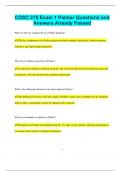
-
COSC 275 Exam 1 Palmer Questions and Answers Already Passed
- Exam (elaborations) • 39 pages • 2024
-
- $10.99
- + learn more
COSC 275 Exam 1 Palmer Questions and Answers Already Passed What are the key components of a Python program? The key components of a Python program include variables, data types, control structures, functions, and input/output operations. How do you define a function in Python? A function in Python is defined using the `def` keyword followed by the function name and parentheses, with the function body indented underneath. What is the difference between a list and a tuple in Pytho...
COSC 2436 Exam 1 Final Exam review Questions and Answers
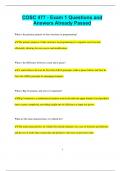
-
COSC 477 - Exam 1 Questions and Answers Already Passed
- Exam (elaborations) • 34 pages • 2024
-
- $10.49
- + learn more
COSC 477 - Exam 1 Questions and Answers Already Passed What is the primary purpose of data structures in programming? The primary purpose of data structures in programming is to organize and store data efficiently, allowing for easy access and modification. What is the difference between a stack and a queue? A stack follows the Last In, First Out (LIFO) principle, while a queue follows the First In, First Out (FIFO) principle for managing elements. What is Big O notation, and why...
COSC 100- Exam 1 (HW 1-4) Questions and Answers
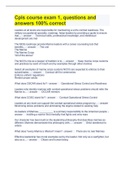
-
Cpls course exam 1, questions and answers 100% correct
- Exam (elaborations) • 3 pages • 2023
-
Available in package deal
-
- $19.49
- 3x sold
- + learn more
Cpls course exam 1, questions and answers 100% correct Leaders at all levels are responsible for maintaining a unit's combat readiness. The military occupational specialty, roadmap, helps leaders by providing a guide to ensure that.... Technical skills, professional knowledge, and intellectual development are met The MOS roadmaps provide Marine leaders with a career counseling tool that benefits.... The unit The Marine The Marine Corps All of the above The NCO's role as a k...
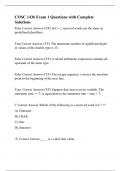
-
COSC 1436 Exam 1 Questions with Complete Solutions
- Exam (elaborations) • 12 pages • 2024
- Available in package deal
-
- $13.99
- + learn more
COSC 1436 Exam 1 Questions with Complete Solutions
COSC Exam 1 Exam
COSC Exam 1

$6.50 for your textbook summary multiplied by 100 fellow students... Do the math: that's a lot of money! Don't be a thief of your own wallet and start uploading yours now. Discover all about earning on Stuvia

